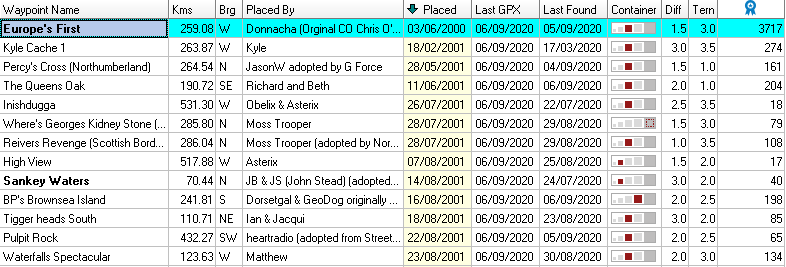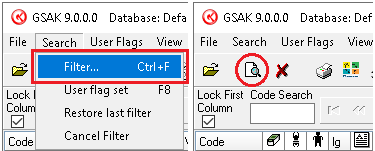We value your privacy
We use essential cookies to make this website work.
In addition, we would like to set cookies to help us understand how our website is used.We use essential cookies to make this website work.
In addition, we would like to set cookies to help us understand how our website is used.
GSAK is a Geocaching management tool available for download. It is only available to Windows users, and restricted to Geocaching.com. Several guides have been published in our Seeker magazine over the years; we have collected them to form an ultimate GAGB GSAK Masterclass below. We hope that you will find it useful.
GSAK Masterclass: Introduction
GSAK Masterclass: How to Get Geocaches
GSAK Masterclass: Sorting and Filtering
Tips on Surviving Without GSAK
GSAK Masterclass: More on GSAK
By Cass Flowers
GSAK (Geocaching Swiss Army Knife) is software that allows you to store and manage an offline database of geocaches and waypoints. To be honest, GSAK can seem a bit daunting at first, because there are so many features packed into it, so anyone in their early days as a geocacher may want to come to terms with Pocket Queries and Bookmark Lists to begin with, before graduating to GSAK. Once taken, however, the step into GSAK-World, will prove a revelation. The software is free to use with no restrictions for 21 days. You may continue to use GSAK after 21 days, but then you get a ‘nag screen' and, if you want to remove that, then you need to register: registration costs $30 USD, just over £18, and that's a one-off fee. The cachers who will benefit most from GSAK are those who go out to find a high number of caches in a day; those who travel to a lot of different places to geocache, and those who like data. In other words, GSAK is for the dedicated, long-term geocacher. This short guide starts at the very beginning and covers a few of the ways to import geocaches into GSAK. In future issues, I'll deal with more complex matters.
Well, if it ain't broke, don't fix it. If you're happy with Pocket Queries and Bookmark Lists, that's the way to do things. But GSAK gives you so much more.
You may then be asked to update your settings so that GSAK is able to identify which Geocaching.com caches in your database belong to you and which you have found. Click ‘Yes'. You will be asked to authorise your account via the Groundspeak API. Enter your username and password as prompted followed by ‘Allow Access'.
Cachers that don't use GSAK will probably be used to downloading a pocket query from Geocaching.com, downloading individual GPX files from geocache pages, or downloading a selection from the map on Opencaching.com and then copying them onto their GPS. Wherever or however you acquire the GPX files of caches you can import the downloaded files into your GSAK database using the following method.
Depending on how many geocaches you are attempting to load, it may take a minute or so to import the caches. Once complete you will see a dialog box summarising how many caches have been found. Select ‘OK', and the caches will be appear in the GSAK database and page template.

By Cass Flowers
Since GSAK version 8, GSAK has been ‘linked' to geocaching.com and allows direct access for downloading caches. Along with this you will find that you have a much nicer interface to use in order to select which geocaches to download. You can use a map to accurately outline the area to retrieve caches from.
This retrieval method will also download data on how many favourite points caches have so you can quickly sort for the best caches in an area. You can initially download up to 30 logs per geocache (instead of just 5 that pocket queries give.
Connect your GPS to your computer. Once it's connected, go into GSAK: all the existing caches in your database should now display.
By Cass Flowers
Sorting is as simple as clicking the column header of the column you want to sort by. To find the oldest geocache in your database, click the ‘Placed' column and it'll appear at the top, or click the ‘Fav Points' column header to sort by caches with the highest favourite points in your database.


Filtering is an enormously powerful feature of GSAK and something that every GSAK user should explore and familiarise themselves with. You can use it to filter the caches in your database so that only certain ones are displayed depending on the criteria that you set. To filter caches, click the ‘Search' menu and then ‘Filter' or click the magnifying glass icon along the top.
You can use the GSAK filters to act as the filters do when you run a pocket query. So one of the most basic filters you might run is for Difficulty and Terrain. To do this, in the filter area you could (for example) set Difficulty Equal to 5.0 and Terrain Equal to 5.0 to show only the hardest caches in your database. To cancel/clear the filter, click the red X icon along the top.

If we want to search for something in the geocache description, open the filter dialog and then under ‘Where to Search' select ‘Selected Items Only' and tick ‘Description' and enter the search term in ‘Full Text Search'.

Instead of searching the Description you could also search through logs in your database by running the previous filter again, but specifying ‘Logs' under ‘Where to search'. For example, you could search the logs for for ‘Best Cache Ever'
GSAK filters also allow you to show only caches which were placed by a certain user, caches with certain words in the title, only caches that were placed on a certain date (for Jasmer challenges), caches that haven't been found for a year or more (for Resuscitator challenges), caches with certain attributes, caches along a defined route, caches that haven't been found by a certain cacher (e.g. if you are planning a caching trip with a friend and only want to find caches that neither of you have found before), and much more.
The best advice for getting to grips with GSAK filters is to play with them. You will soon get the hang of them after spending a bit of time experimenting.
By Jen Harley
GSAK, whilst a powerful Geocaching tool, can only be downloaded on Windows PCs. It is also restricted to Premium users of Geocaching.com. Jen Harley (Maple Leaf) explores the alternatives to GSAK in the below article.
Because I am not a ‘numbers person' and with so many geocaches to choose from, I normally read the geocache pages in advance and choose the ones I want to do - rather than just run a PQ (pocket query) with 500 or 1000 caches.
Tip - When creating your bookmark, don't ‘Share it' - otherwise everyone will be able to read your notes and puzzle answers!
Tick the day/s you want your PQ to run. If you have written additional notes on your bookmark - then print that out.
Tip - check all pages have printed as I have been caught out by this a couple of times.
*The GAGB wish to clarify, in the light of clause C8 of our Constitution, that the Association is under no commercial influence from GSAK (which is a commercial product), neither are we promoting it over any other alternative. We are simply aware that many cachers use the program and would benefit from a detailed GSAK guide on our website.